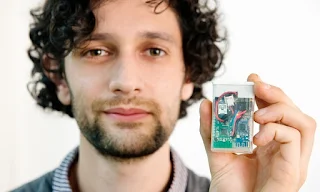A glucose monitor in a tic-tac box
.
Health hackers: the patients taking medical innovation into their own hands | Life and style | The Guardian
Tim Omer is a 31-year-old diabetic. Rolling up his sleeve, he reveals a small box, about half the size of a cigarette packet, taped to his upper arm. From the box, a sensor runs under his skin, delivering a readout of his blood glucose level to his mobile phone.
This is something to which few Type 1 diabetics in Britain have access – the monitors cost around £4,000 a year to buy and maintain and are too expensive for the NHS.
But Omer is no ordinary patient. He is a citizen hacker. Tired of waiting for the pharmaceutical and medical device companies to come up with new, affordable ways to improve the lives of diabetic patients, he has taken matters into his own hands.
A self-confessed geek, he bought an old continuous glucose monitor (CGM) from the internet and used his skills as an IT specialist to re-engineer it so that it communicates, via a self-built Tic Tac box receiver he keeps in his pocket, with his mobile phone and his smartwatch – something even the full-price version will not do. The total annual cost is about £1,000. With a couple of taps on the screen, his blood glucose level is displayed as a graph.
Citizen hackers have appeared on both sides of the Atlantic, working on improvements to existing aids for sick and disabled people. A recent article in the Washington Post described how technologically savvy patients have tweaked hearing aids so they play music, used 3D printers to make their own prosthetics and improved breast pumps for new mothers. These ideas emerged not from scientists in research labs, but from patients at the grassroots who are actually using the devices they have developed.
People with diabetes have adopted a rallying cry – #wearenotwaiting – signalling their impatience to find new solutions and spread the word to other users. “My aim is to publish my work, and others’, so as many people as possible can benefit. If you try to commercialise [your own products], you run up against all sorts of regulatory barriers,” he says.
This should sound alarm bells. Regulatory barriers are there for a reason. Diabetes is a potentially life-threatening condition and patients come to rely on the devices they use, which must work reliably and predictably. If modified devices were used before going through a rigorous testing and approval process, they could put patients’ health at serious risk.
But we need to go further. We must find a way to harness the talent that is out there and the desire of patients to become involved in their own care while protecting them from unregulated experimentation. It may be that, in this way, we can sow the seeds of the next healthcare revolution.


No comments:
Post a Comment